Day one
Traveling with a 4000 lb boat is not for the faint
hearted. Not that the boating is anything special,
but as every sailor knows, the most hazardous thing
at sea is land. The planned destination was theThousand
Islands in the St Lawrence River. Labor Day week-end
came and went, and with the departure date of Tuesday,
we left far too little time for provisioning. Everything
was done at the last minute, (a proverb comes to mind:
“haste....”). The diesel overflowed into
the bilge, the hydraulic brake in the trailer proved
to be out of fluid, the lines and shrouds were a Gordian
tangle. Sue said “Shall we check the trailer
lights?” and I said “What do you think
we’ll do if they don’t work?” Nevertheless,
they did work, the diesel got cleaned up (mostly),
and we had an uneventful ride to the St Lawrence.
It may be a case of being penny wise and pound foolish:
the idea was to use our Empire State Passport (free
entry and vehicle storage) and avoid the charge of
using a real marina. We went to Cedar Point State
Park, auspiciously located just to the south west
of the Wolf Island Cut, but found that launch suitable
only for canoes, bateaux and bath toys. So we turned
back to the east, to choice #2, Wellsley Island State
Park. The launch looked deep enough and the boat went
in fine, floating majestically off the trailer. Sue
was at the helm backing out as I heard dimly out the
window of the truck, “Oh hai! I’m in reverse
and I’m not moooving!"
In retrospect it is easy to see why. This is fishing
central for the Thousand Islands, and many of the
bass boats that load up here use the technique of
powerloading..... Imagine you are sediment at the
end of the launch ramp and a prop wash from a 250
hp outboard motor hits you at point blank range. Of
course you are going to retreat in the face of this
superior force and go back, oh about ten feet, and
there form a defensive bulwark against subsequent
assaults. At the end of the ramp the launch was 4
ft deep; ten feet beyond that it was about two. (*1)
We managed to push off the bar with the help of an
anonymous benefactor, and spent the night rigging
the boat and worrying about where we were going to
take it out. That night by a seacook dinner of Progresso
soup, cheese with tomatoes on toast, and Fingerlakes
riesling, we enjoyed the company of turtles, mink
and squawking herons. Aside from somehow contriving
to get the lazy jack on the wrong side of the mast
(I cut it to avoid taking the mast down again), the
evening came off quite well.
 |
Wellsley - (notice
the splice in the lazy jack)
click images
to enlarge |
Day 2
The next morning we drove to Clayton and arranged
for the take out at a commercial marina (Islander)
where the owners were wonderfully generous in agreeing
to help us get the truck and trailer from Wellsley.
Then off on the high seas. There was not much wind,
but we had a pleasant motor (drawing down the tank
so it wouldn’t spill when we heeled under sail).
We arrived in Kingston, Ontario that afternoon. Kingston
was the home port of the Canadian Great Lakes Navy
in the war of 1812 (*2),
and there are numerous fortifications surrounding
it, including the massive Fort Henry.
| Fort Henry - What
is the defensive function of those long ditches
running to the water? |
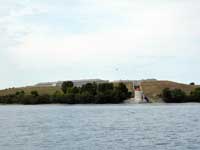
|
We stayed in Confederation Basin Marina. The charm
of cruising to Kingston is partly based on the assumption
that some crew members might like a break from seafaring:
walking the promenades, shopping, being seen. But
Sue and I are both from the country and have personal
spaces of several square yards each. I did see a few
interesting items: red flannel boxers with black bears,
and squeaky pet toys with names like “desperate
house dogs” (use your imagination here). We
beat a retreat back to the boat for another excellent
dinner. Sue packed peaches, tomatoes and late season
Kent mangoes (about the size of large hand grenades)
in the christmas ornament box to prevent bruising
in the hold (*3);
the riesling was protected in a sturdy glass bottle
and stuffed in the mattress.
Confederation Basin is in the center of the old
town, flanked by grand gray stone buildings and a
circular Mareno tower built to defend against American
incursion during the Oregon crisis. It is charming,
but as evening falls the clock in City Hall bongs
the hour whether you want it to or not, and there
are the ubiquitous additional sounds of the city that
never sleeps: motorcycles apparently without mufflers,
high pitched laughter, sirens, and Elton John’s
greatest hits over and over (there were quite a few
of them). And yet day comes again as ever.
Day 3
The payback for staying here is a short walk to
a civilized breakfast; Pan Chancho is on Princess
street, where one can acquire croissants, fine cheese,
and real coffee. And, I prudently never leave there
without a large dry sausage to hang in the boat against
famine.
My wife is a novice sailor. We had discussed the
hypothetical passage to Waupoos Island. She was not
enthusiastic about spending much time in the open
water of Lake Ontario, but she remained flexible about
itinerary. It is amazing how motivating a colorful
sash with merit badges (“ Sea Cub Cadet”,
“Master of Sheets”, “Anchoring Under
Duress”, and “Propwalk 101” ) can
be for a grown woman who was a brownie and a girl
scout.
We sailed out into the harbor and south into the
Big Water. The wind was a perfect 10-15 SSE. We were
able to clear Amherst Island on one tack (with a small
power assist from the Volvo). But two hours later
Waupoos was still another 20 miles onward and, although
the romance of the passage called me, a captain has
to know his crew. So one jibe around the west end
of Amherst and we were able to get back to Kingston
on a single tack; a total run of 35 miles. We had
to head back to Kingston anyway since Sue had left
her sandals on the dock. I was filled with the peace
that only comes to he who dares to accomplish something
on vacation.
 |
Sue at Sea -
(the sash is under the pfd) |
Another night in Confederation Basin. What did the
Americans do during the Oregon Crisis to warrant a
fort guarding the marina? Dinner in the Pilot House,
specializing in all things fried from the sea and
good beer.... and a hot shower in the marina.... and
another night listening to the bongs (I imagined a
Terry Pratchett Watchman (4*)
knocking on our boat and saying “ You guys all
right in there?” and then calling to his partner,
“All’s well at #46!”, moving on
along the docks all night long in a cheerful chorus
of reassurance.) It was a bit like camping on a bench
in Central Park.
| Confederation Basin
- notice the large clock tower in the background |
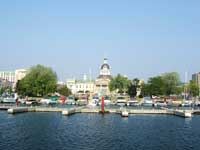
|
Day 4
Our friend Noaa warned us that the perfect sailing
weather was not to last. With the forecast of 20K
winds dead on our nose the next day, we decided to
head back to Clayton. But first, (insert another Pan
Chancho breakfast here).
Rounding the break wall at Kingston we plowed into
6’ waves while I hoisted the sails, one hand
for me, one for the halyard, one for the topping lift,
one for... is there another hand somewhere? My valiant
first mate, promoted now with a new merit badge for
heaving-to (not something you do when you forget the
scopolamine patch), muscled the helm into the wind.
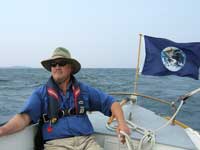 |
Heading for
Clayton - We settled down to a memorable passage. |
With the sails up (one reef) we turned SE and the
pitching immediately stopped; we settled down to a
memorable passage. It was a single tack to Clayton,
including navigating the Wolf Island Cut under sail
(purist take note: no engine was used here, and no
animals were harmed): 22 miles averaging 6 knots,
and at times 7.5K over the ground by gps (the great
lakes outflow contributing somewhat). It was a wonderful
beam reach almost all the way, and although the boat
steers a little wild with a following sea, captain
and crew held up doggedly.. First mate did acknowledge
that the steering under these conditions resulted
in a high UFR (urinary frequency ratio).
| Docked at Clayton |
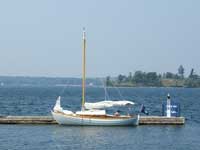
|
The trip to Clayton is worth it for the the Antique
Boat Museum alone. This is mecca for the old wooden
runabout pilgrims. In the last ten years it has been
extensively and beautifully renovated. There is now
a complex of buildings housing all manner of boats,
with a fleet of restored classics in the water. If
you can’t afford the price of admission, simply
walking the docks at the marinas will fill your plate
with old beauties, from runabouts to wooden cabin
cruisers the size of town houses. https://www.abm.org/
So, down with the rig again. As Sue stood by the
ramp, I backed the boat into a pier and put a ding
in the rudder. Of course, everyone had to notice it
when we pulled out and point it out to me.
The Philosophical part
Was it worth it? At the time it seemed like a long
run for a short slide, wrestling the rig up and down,
driving, launching, all for two days of great sailing.
But I know I would have been unhappy if we had stayed
at home, so I guess doing it was the lesser of two
weevils.
On the drive back I found myself singing that old
Duke Ellington chestnut “It don’t mean
a thing if it aint got that ding”. Sue said,
“I’m glad you hit the pier and not me.”
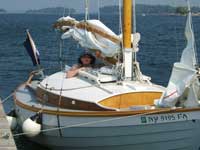 |
The peaches
were still fresh |
footnotes
*1 The proper authorities have been notified but
another letter or two wouldn’t hurt
*2 Warships of the Great Lakes- Robert Malcomson 2001
*3 no US vegetable matter ever actually left the boat
*4 Terry Pratchett is my favorite author of 2007;
a wonderfullly bizarre sense of humor and some 50
discworld novels to choose from. Try “Thief
of Time”. or “Going
Postal”. or “Thud”.
or “Hogfather”.


More about Waterdog
|